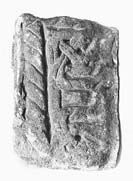Select a site alphabetically from the choices shown in the box below. Alternatively, browse sculptural examples using the Forward/Back buttons.
Chapters for this volume, along with copies of original in-text images, are available here.
Object type: Fragment of grave-cover
Measurements: L. 28 cm (11 in) W. 37 cm (14.5 in) D. 17 cm (6.75 in)
Stone type: Grey oolitic limestone, a grainstone composed of closely-packed ooliths of 0.4mm diameter (range 0.3 to 0.5mm), as Lincoln St Mark 1 and 14. Ancaster Freestone, Upper Lincolnshire Limestone, Inferior Oolite Group
Plate numbers in printed volume: Fig. 9; Ill. 238
Corpus volume reference: Vol 5 p. 199
(There may be more views or larger images available for this item. Click on the thumbnail image to view.)
The stone is a fragment from a large flat-topped chest-like cover of mid-Kesteven type. It has been cut up and so reworked for secondary use or uses that only a small area of its original decorated surface survives and no original edge in any direction. That reworking includes squaring on a skew to its original form, a chamfered angle on the upper decorated surface, and a large rebate cut in its underside.
A (top): The decoration is executed in low relief and comprises the ends of two zones of simple pattern F interlace that develop from the corners of a rectangular cross-arm of type A1. The interlace strands have an incised medial line. The cross-arm itself has a border defined by a subsidiary incised line and decorated with cable moulding, and the whole panel is also edged with it. The remains of another cable moulding forms the edge of a further panel beyond the cross-arm.
Contrary to its previous recent assessment (Stocker 1986a, 80), the style, layout and design details make it certain that this fragment comes from the lid of a large grave-cover of mid-Kesteven type (see Chapter V). It forms one end of the typical central motif of double-ended crosses with interlace infilling (Fig. 9). The trick of developing the interlace from the corners of the cross is paralleled at Aisthorpe (Ill. 1), Burton Pedwardine (Ill. 78), Eagle (Ill. 160) and West Allington (Ill. 384) in Lincolnshire, and at East Bridgeford, Girton, Hawkesworth, Kneesall and Rolleston in Nottinghamshire. For the special elaboration of the cross-arm with cabling the best direct analogy is the large cover from Peterborough (Fox 1920–1, pl. III), but the mid-Kesteven group has cabling within its decorative repertoire, as for example with the cabled ribs separating runs of asymmetrical interlace on the sides at Lincoln St Mary-le-Wigford 2, Corringham 1 and elsewhere, and the cross on Colsterworth 3 (Ill. 89) is also surrounded by a border.



